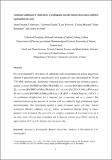Antitumor platinum(IV) derivatives of carboplatin and the histone deacetylase inhibitor 4-phenylbutyric acid

View/
Date
2017-09-10Author
Almotairy, Awatif Rashed Z.
Gandin, Valentina
Morrison, Liam
Marzano, Cristina
Montagner, Diego
Erxleben, Andrea
Metadata
Show full item recordUsage
This item's downloads: 347 (view details)
Cited 23 times in Scopus (view citations)
Recommended Citation
Almotairy, Awatif Rashed Z., Gandin, Valentina, Morrison, Liam, Marzano, Cristina, Montagner, Diego, & Erxleben, Andrea. (2017). Antitumor platinum(IV) derivatives of carboplatin and the histone deacetylase inhibitor 4-phenylbutyric acid. Journal of Inorganic Biochemistry, 177, 1-7. doi: https://doi.org/10.1016/j.jinorgbio.2017.09.009
Published Version
Abstract
Five new platinum(IV) derivatives of carboplatin each incorporating the histone deacetylase inhibitor 4-phenylbutyrate in axial position were synthesized and characterized by 1H and 195Pt NMR spectroscopy, electrospray ionization mass spectrometry and elemental analysis, namely cis,trans-[Pt(CBDCA)(NH3)2(PBA)(OH)] (1), cis,trans-[Pt(CBDCA)(NH3)2(PBA)2] (2), cis,trans-[Pt(CBDCA)(NH3)2(PBA)(bz)] (3), cis,trans-[Pt(CBDCA)(NH3)2(PBA)(suc)] (4) and cis,trans-[Pt(CBDCA)(NH3)2)(PBA)(ac)] (5) (PBA = 4-phenylbutyrate, CBDCA = 1,1-cyclobutane dicarboxylate, bz = benzoate, suc = succinate and ac = acetate). The reduction behavior in the presence of ascorbic acid was studied by high performance liquid chromatography. The cytotoxicity against a panel of human tumor cell lines, histone deacetylase (HDAC) inhibitory activity, cellular accumulation and the ability to induce apoptosis were evaluated. The most effective complex, compound 3, was found to be up to ten times more effective than carboplatin and to decrease cellular basal HDAC activity by approximately 18% in A431 human cervical cancer cells.

